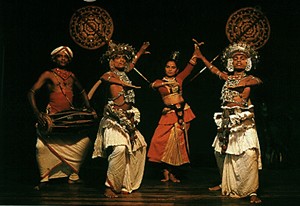

All roads in London will lead to the Brent Town Hall in Wembley on 31 August 1997 where a kaleidoscope of Sri Lankan traditional dances developed over 25 centuries will be presented by twelve members of the Sri Lanka State Dance Ensemble. This rare cultural evening is organised by The Sri Lankan Educational, Cultural and Welfare Foundation in Kingsbury, London, with the sponsorship of the Ministry of Cultural Affairs & Buddha Sasana and Air Lanka.
The cultural show will commence at 1.30 p.m. with a unique art exhibition by Ven. Katuwana Piyananda, depicting the profundity of Buddhist philosophy on canvas. Both these events are to raise funds for the Sri Saddhatissa International Buddhist Centre, which comes under the umbrella of the World Buddhist Foundation, a Registered Charity in England, to provide more accommodation facilities and public conveniences for the increasing activities of the participants. Sri Lankan Buddhist centres or temples in India, Washington, Los Angeles, New York, Geneva, Paris, or Birmingham and Leicester in Britain have facilities to cater for an emergency accommodation situation of a desperate Sri Lankan visitor, but in London it is a different story. After the closing down of the Ceylon Student Centre many moons ago there are no welfare provisions at the Sri Lanka High Commission to come to the aid of a desperate or stranded Sri Lankan national in a helpless situation! Sri Saddhatissa International Buddhist Centre is, therefore, regarded as a rescue haven today for any helpless Sri Lankan stranger to London who genuinely needs help in the form of accommodation.
Sri Saddhatissa Buddhist Centre, was founded by Ven. Galayaye Piyadassi Thero, a pupil of the eminent Buddhist scholar and promulgator of Buddhism to the UK for over quarter of a century Ven. Dr. Hamallawa Saddhatissa. The Centre is managed privately by a dedicated group of devotees and is not funded by any other charitable organisation. Philanthropic as well religious and cultural activities of this institution by its chief incumbent & residents monks are widely known in London as well as in Sri Lanka, especially the Ministry of Cultural Affairs & Buddhism and the Ministry of Plan Implementation, Ethnic Affairs and National Integrity.
The Cultural Evening and the Art Exhibition will undoubtedly leave a lasting impression on Londoners and will afford a rare opportunity to appreciate the complexity and uniqueness of the Sri Lankan dance culture blended in legend, myth, history and religion with its ritualistic and exorcist aspects portrayed through songs, dance movements and martial techniques in their colourful, vibrant and exciting forms. Linked to but separate from India, Sri Lanka has its own highly developed, complex and unique dance culture developed over 25 centuries. These dances stylistically represent traditional occupations, religious practices, rites and rituals.
The folk songs of Sri Lanka spring from various occupations of the people. The woman who transplants paddy or helps her husband to gather the season's harvest sings songs of joy not only to relieve the monotony of daily work, but also to express the thrills and pleasures she extracts from life. When the emotions are too much for the songs alone she expresses her joy through rhythmic movements of her body. Groups of women with pitchers in hand would dance in circles and sing lilting songs. The men folk similarly have their own forms of dance. These dances emphasise the strength and virility of youth, and the quieter and more dignified forms of dance are offered as pious tributes to the deities.
The dances of Sri Lanka fall into two main types distinct from each other. The Kandyan dance or the Udarata Netum was nurtured and grew in the hill country and the low country dance or the Pahatharata Netum had its origin in South Sri Lanka. Certain underlying aesthetic principles are common to both. A unity of technical features and a mythological and historical closeness each constitutes a distinct technique and a separate tradition. The two schools differ in costume, music, body training and movement and these differences are immediately apparent from the kind of dance movements and the sound of drums.
The State Dance Ensemble is due to fly to London some time this week.
The Sri Lanka Educational, Cultural and Welfare Foundation has
successfully arranged the BBC television to film the troupe in action
for one of their popular family programmes (The Generation Game), a
public relations exercise which the Cultural Foundation can be proud of
- having introduced to the world media where millions of viewers will be
able to witness. This will undoubtedly enable Sri Lanka to be a common
topic for discussion in offices and households the world over which has
already commenced with Sri Lankan cricket at first and subsequently with
athletics especially after the last few weeks. The Dance ensemble is
expected to perform in Birmingham, Paris and Geneva after their first
show in London on 31 August.
